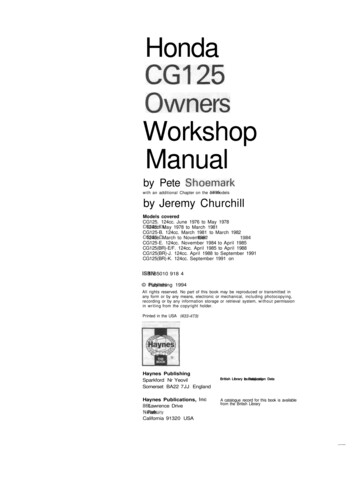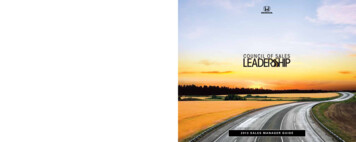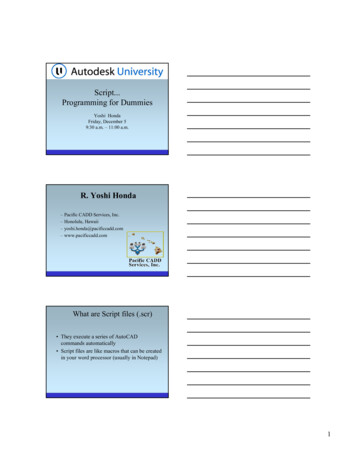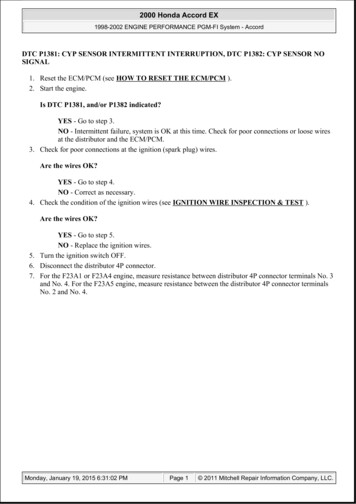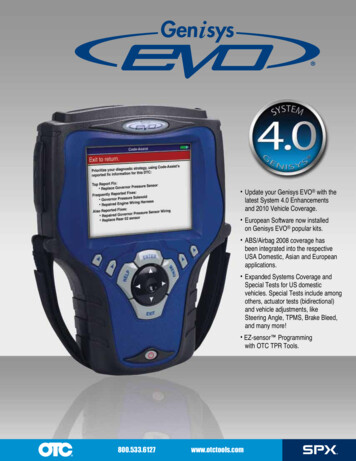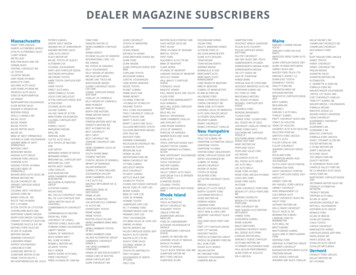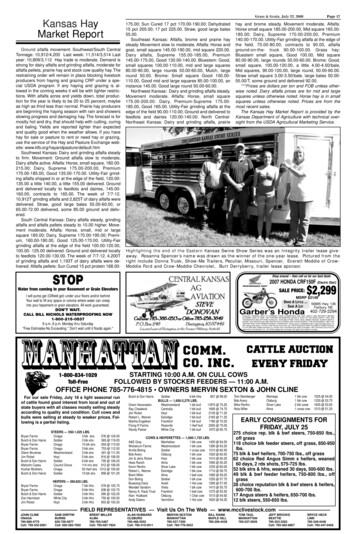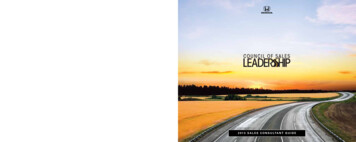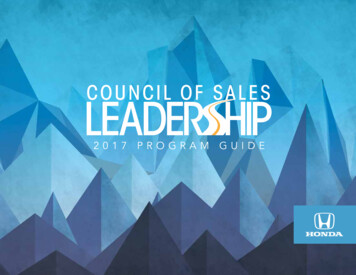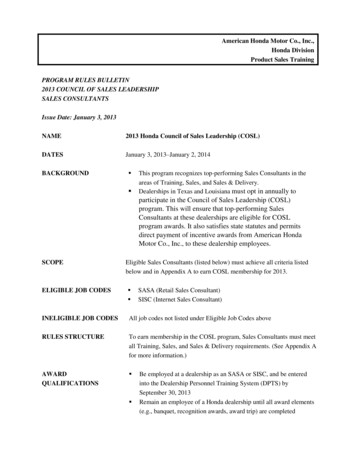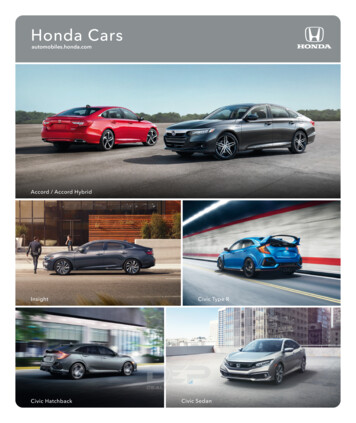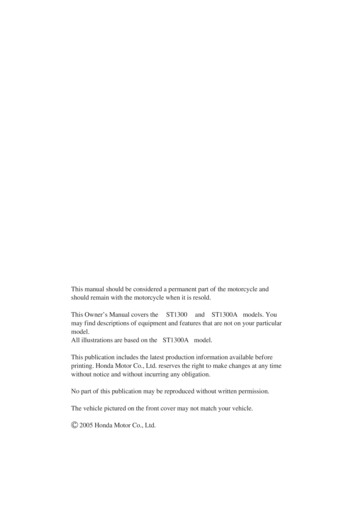
Transcription
05/11/02 15:06:17 31MCS630 001This manual should be considered a permanent part of the motorcycle andshould remain with the motorcycle when it is resold.This Owner’s Manual covers the ST1300 and ST1300A models. Youmay find descriptions of equipment and features that are not on your particularmodel.All illustrations are based on the ST1300A model.This publication includes the latest production information available beforeprinting. Honda Motor Co., Ltd. reserves the right to make changes at any timewithout notice and without incurring any obligation.No part of this publication may be reproduced without written permission.The vehicle pictured on the front cover may not match your vehicle.2005 Honda Motor Co., Ltd.
05/11/02 15:06:20 31MCS630 0022006Honda ST1300/AOWNER’S MANUAL
05/11/02 15:06:25 31MCS630 003IntroductionCongratulations on choosing your Honda motorcycle.When you own a Honda, you’re part of a worldwide family of satisfiedcustomers people who appreciate Honda’s reputation for building quality intoevery product.Before riding, take time to get acquainted with your motorcycle and how itworks. To protect your investment, we urge you to take responsibility forkeeping your motorcycle well maintained. Scheduled service is a must, ofcourse. But it’s just as important to observe the break-in guidelines, and performall pre-ride and other periodic checks detailed in this manual.We also recommend that you read this owner’s manual before you ride. It’s fullof facts, instructions, safety information, and helpful tips. To make it easy to use,the manual contains a detailed list of topics at the beginning of each section, andboth an in-depth table of contents and an index at the back of the book.As you read this manual, you will find information that is preceded by asymbol. This information is intended to help you avoid damage to yourHonda, other property, or the environment.Introduction
05/11/02 15:06:31 31MCS630 004IntroductionRead the Warranties Booklet (page 192 ) thoroughly so you understand thecoverages that protect your new Honda and are aware of your rights andresponsibilities.If you have any questions, or if you ever need special service or repairs,remember that your Honda dealer knows your motorcycle best and is dedicatedto your complete satisfaction.Please report any change of address or ownership to your Honda dealer so wewill be able to contact you concerning important production information.You may also want to visit our website at www.honda.com.Happy riding!California Proposition 65 WarningWARNING: This product contains or emits chemicals known to the State ofCalifornia to cause cancer and birth defects or other reproductive harm.Introduction
05/11/02 15:06:38 31MCS630 005A Few Words About SafetyYour safety, and the safety of others, is very important. And operating thismotorcycle safely is an important responsibility.To help you make informed decisions about safety, we have provided operatingprocedures and other information on labels and in this manual. This informationalerts you to potential hazards that could hurt you or others.Of course, it is not practical or possible to warn you about all hazards associatedwith operating or maintaining a motorcycle. You must use your own goodjudgment.You will find important safety information in a variety of forms, including:Safety Labels –– on the motorcycle.Safety Messages –– preceded by a safety alert symbolsignal words: DANGER, WARNING, or CAUTION.and one of threeThese signal words mean:You WILL be KILLED or SERIOUSLY HURTif you don’t follow instructions.You CAN be KILLED or SERIOUSLY HURTif you don’t follow instructions.You CAN be HURT if you don’t followinstructions.Safety Headings –– such as Important Safety Reminders or Important SafetyPrecautions.Safety Section –– such as Motorcycle Safety.Instructions –– how to use this motorcycle correctly and safely.This entire manual is filled with important safety information –– please read itcarefully.Safety Messages
05/11/02 15:06:47 31MCS630 006ContentsThese pages give an overview of the contents of your owner’s manual. The firstpage of each section lists the topics covered in that section.Motorcycle Safety .Important safety information you should know, plus a look at the safetyrelated labels on your motorcycle.1Instruments & Controls . 11The location and function of indicators, gauges, and controls on yourmotorcycle and operating instructions for various controls and features.Before Riding . 37The importance of wearing a helmet and other protective gear, how to makesure you and your motorcycle are ready to ride, and important informationabout loading.Basic Operation & Riding . 51How to start and stop the engine, shift gears, and brake. Also, ridingprecautions and important information about riding with a passenger or cargo.Servicing Your Honda . 67Why your motorcycle needs regular maintenance, what you need to knowbefore servicing your Honda, an owner maintenance schedule, andinstructions for specific maintenance and adjustment items.Contents
05/11/02 15:06:57 31MCS630 007ContentsTips . 141How to store and transport your motorcycle and how to be anenvironmentally-responsible rider.Taking Care of the Unexpected . 147What to do if you have a flat tire, your engine won’t start, etc.Technical Information . 171ID numbers, technical specifications, and other technical facts.Consumer Information . 189Information on warranties, emission controls, how to get Honda servicemanuals, and.‘‘Reporting Safety Defects’’ . 197Table of Contents . 198Sequential listing of topics in this owner’s manual.Index. 204Quick ReferenceHandy facts about fuel, engine oil, tire sizes, and air pressures.Contents
05/11/02 15:07:00 31MCS630 008Motorcycle SafetyThis section presents some of the most important information andrecommendations to help you ride your motorcycle safely. Please take a fewmoments to read these pages. This section also includes information about thelocation of safety labels on your motorcycle.Important Safety Information . 2Accessories & Modifications . 4Safety Labels . 6Motorcycle Safety1
05/11/02 15:07:06 31MCS630 009Important Safety InformationYour motorcycle can provide many years of service and pleasure if you takeresponsibility for your own safety and understand the challenges you can meetwhile riding.There is much that you can do to protect yourself when you ride. You’ll findmany helpful recommendations throughout this manual. The following are afew that we consider most important.Always Wear a HelmetIt’s a proven fact: helmets significantly reduce the number and severity of headinjuries. So always wear an approved motorcycle helmet and make sure yourpassenger does the same. We also recommend that you wear eye protection,sturdy boots, gloves, and other protective gear (page 38 ).Take Time to Learn & PracticeEven if you have ridden other motorcycles, take time to become familiar withhow this motorcycle works and handles. Practice in a safe area until you buildyour skills and get accustomed to the motorcycle’s size and weight.Because many accidents involve inexperienced or untrained riders, we urge allriders to take a certified course approved by the Motorcycle Safety Foundation(MSF). See page 40 .Ride DefensivelyThe most frequent motorcycle collision happens when a car turns left in front ofa motorcycle. Another common situation is a car moving suddenly into yourlane.Always pay attention to other vehicles around you, and do not assume that otherdrivers see you. Be prepared to stop quickly or make an evasive maneuver. Forother riding tips, see the booklet, You and Your Motorcycle: Riding Tips andPractice Guide, which came with your new motorcycle (USA only).2Motorcycle Safety
05/11/02 15:07:11 31MCS630 010Important Safety InformationMake Yourself Easy to SeeSome drivers do not see motorcycles because they are not looking for them. Tomake yourself more visible, wear bright reflective clothing, position yourself soother drivers can see you, signal before turning or changing lanes, and use yourhorn when it will help others notice you.Ride within Your LimitsPushing limits is another major cause of motorcycle accidents. Never ridebeyond your personal abilities or faster than conditions warrant. Remember thatalcohol, drugs, fatigue, and inattention can significantly reduce your ability tomake good judgments and ride safely.Don’t Drink and RideAlcohol and riding don’t mix. Even one drink can reduce your ability to respondto changing conditions, and your reaction time gets worse with every additionaldrink. So don’t drink and ride, and don’t let your friends drink and ride either.Keep Your Honda in Safe ConditionIt’s important to keep your motorcycle properly maintained and in safe ridingcondition. To help avoid problems, inspect your motorcycle before every rideand perform all recommended maintenance. Never exceed load limits (page 44 ),and do not modify your motorcycle (page 5 ) or install accessories that wouldmake your motorcycle unsafe (page 4 ).Motorcycle Safety3
05/11/02 15:07:18 31MCS630 011Accessories & ModificationsModifying your motorcycle or using non-Honda accessories can make yourmotorcycle unsafe. Before you consider making any modifications or adding anaccessory, be sure to read the following information.Improper accessories ormodifications can cause a crashin which you can be seriouslyhurt or killed.Follow all instructions in thisowner’s manual regardingaccessories and modifications.AccessoriesWe strongly recommend that you use only genuine Honda accessories that havebeen specifically designed and tested for your motorcycle. Because Hondacannot test all other accessories, you must be personally responsible for properselection, installation, and use of non-Honda accessories.Check with your Honda dealer for assistance and always follow theseguidelines:Make sure the accessory does not obscure any lights, reduce ground clearanceand lean angle, limit suspension travel or steering travel, alter your ridingposition, or interfere with operating any controls.Do not add any electrical equipment that will exceed the motorcycle’selectrical system capacity (page 177 ). A blown fuse can cause a loss of lightsor engine power (page 165 ).Do not pull a trailer or sidecar with your motorcycle. This motorcycle was notdesigned for these attachments, and their use can seriously impair yourmotorcycle’s handling.Carefully consider the weight of any accessories and any cargo stored inthose accessories to avoid exceeding the maximum weight limits.For more information, see Load Limits, page 44 .4Motorcycle Safety
05/11/02 15:07:22 31MCS630 012Accessories & ModificationsModificationsWe strongly advise you not to remove any original equipment or modify yourmotorcycle in any way that would change its design or operation. Such changescould seriously impair your motorcycle’s handling, stability, and braking,making it unsafe to ride.Removing or modifying your lights, exhaust system, emission control system, orother equipment can also make your motorcycle illegal.Motorcycle Safety5
05/11/02 15:07:31 31MCS630 013Safety LabelsSafety labels on your motorcycle either warn you of potential hazards that couldcause serious injury or they provide important safety information. Read theselabels carefully and don’t remove them.If a label comes off or becomes hard to read, contact your Honda dealer for areplacement.CARGO LIMIT10.0 lbs (4.5 kg)6CARGO LIMITCARGO LIMIT20.0 lbs (9.0 kg)4.5 lbs (2.0 kg)Motorcycle Safety
05/11/02 15:07:35 31MCS630 014Safety LabelsCARGO LIMITCARGO LIMIT4.5 lbs (2.0 kg)20.0 lbs (9.0 kg)Motorcycle Safety7
05/11/02 15:07:44 31MCS630 015Safety Labels For USA For Canada 8Motorcycle Safety
05/11/02 15:07:51 31MCS630 016Safety LabelsMotorcycle Safety9
05/11/02 15:07:53 31MCS630 01710Motorcycle Safety
05/11/02 15:07:58 31MCS630 018Instruments & ControlsThis section shows the location of all gauges, indicators, and controls you wouldnormally use before or while riding your motorcycle.The items listed on this page are described in this section. Instructions for othercomponents are presented in other sections of this manual where they will bemost useful.Operation Component Locations . 12Gauges & Indicators . 15Multi-displayInitial Display . 20Fuel Gauge. 21Coolant Temperature Gauge . 21Air Temperature Meter . 22Fuel Consumption Meter . 23Current Fuel Consumption . 25Average Fuel Consumption . 25Available Driving Distance. 26Remaining Fuel . 26Odometer/Tripmeter. 27Digital Clock . 28Mileage Unit Change . 29Display Illumination Adjustment. 29Controls & FeaturesIgnition Switch . 30Start Button . 31Engine Stop Switch . 32Headlight Dimmer Switch . 33Turn Signal Switch . 33Horn Button . 34Windshield Height Adjustment Switch . 34Hazard Warning System Switch . 34Headlight Beam Adjustment Knob . 35Instruments & Controls11
05/11/02 15:08:02 31MCS630 019Operation Component Locationsheadlight beam adjustment knobignition switchbrake leverclutchleverthrottle gripfuel fill capleft fairing pocketleft handlebar controls12Instruments & Controlsright fairing pocketright handlebar controls
05/11/02 15:08:06 31MCS630 020Operation Component Locationshelmet holderright saddlebagbrake pedalInstruments & Controls13
05/11/02 15:08:09 31MCS630 021Operation Component Locationsleft saddlebaghelmet holdershift lever14Instruments & Controls
05/11/02 15:08:16 31MCS630 022Gauges & IndicatorsThe gauges, indicators and displays on your motorcycle keep you informed,alert you to possible problems, and make your riding safer and more enjoyable.Refer to the gauges, indicators and displays frequently. Their functions aredescribed on the following pages.USA: Speedometer, odometer & tripmeter read in miles.Canada: Speedometer, odometer & tripmeter read in kilometers.speedometerright turn signal indicatorleft turn signal indicatormulti-displaytachometer red zoneneutral indicatortachometerCLOCK/ILLUM buttonTRIP/M buttonFCD/H buttonPGM-FI malfunctionindicator lamp (MIL)anti-lock brake system (ABS) indicator(Models equipped with ABS)low oil pressure indicatorhigh beam indicatorInstruments & Controls15
05/11/02 15:08:21 31MCS630 023Gauges & IndicatorsLamp CheckMost of the indicator lights come on when you turn the ignition switch ON soyou can check that they are working. Some indicators turn off after a fewseconds; others remain on until or after the engine is started. The ABS indicatorgoes off after you ride the motorcycle at a speed above 6 mph (10 km/h). Allindicators are identified on the following pages with the words: Lamp Check.When applicable, the high beam and neutral indicators come on when you turnthe ignition switch ON and remain on until you select the low beam or shift outof neutral.If one of these indicators does not come on when it should, have your Hondadealer check for problems.16Instruments & Controls
05/11/02 15:08:31 31MCS630 024Gauges & IndicatorsspeedometerShows riding speed in miles (USA) or kilometers (Canada) per hour.tachometerShows engine speed in revolutions per minute (rpm).tachometer red zoneShows excessive engine rpm range (indicated from the beginning of thetachometer red zone) in which operation may damage the engine. Do not let thetachometer needle enter the red zone.turn signal indicator (amber)Flashes when either turn signal operates.neutral indicator (green)Lights when the transmission is in neutral.Instruments & Controls17
05/11/02 15:08:41 31MCS630 025Gauges & Indicatorslow oil pressure indicator (red)Lights when engine oil pressure is low enough to cause engine damage. If thelow oil pressure indicator lights during operation, pull safely to the side of theroad. See page 164 for instructions and cautions. Lamp Check.PGM-FI malfunction indicator lamp (MIL) (red)Lights when there is any abnormality in the PGM-FI (Programmed FuelInjection) system. Should also light for a few seconds and then go off when theignition switch is turned ON and the engine stop switch is at RUN. If theindicator comes on at any other time, reduce speed and take your motorcycle toa Honda dealer as soon as possible. Lamp Check.anti-lock brake system (ABS) indicator (red)(Models equipped with ABS)Lights when there is any abnormality in the anti-lock brake system (ABS).Normally, this indicator comes on when the ignition switch is turned ON, andgoes off after you ride the motorcycle at a speed above 6 mph (10 km/h). If theindicator comes on while riding, stop the motorcycle in a safe place and turn offthe engine. Refer to ABS Indicator, page 61 . For information about ABS, seepage 60 . Lamp Check.high beam indicator (blue)Lights when the headlight is on high beam.18Instruments & Controls
05/11/02 15:08:48 31MCS630 026Gauges & IndicatorsCLOCK/ILLUM buttonUse this button for the following purposes.To adjust timeTo adjust display illuminationFCD/H buttonUse this button for the following purposes.To adjust timeTo select and reset the fuel mileage meterTo change the mileage units for the odometer/tripmeter and available drivingdistanceTRIP/M buttonUse this button for the following purposes.To adjust timeTo select and reset the tripmeterInstruments & Controls19
05/11/02 15:08:54 31MCS630 027Multi-displayYour motorcycle is equipped with a Multi-display that presents various displays.This section explains display functions and operations.Initial DisplayWhen the ignition switch is turned ON, the display will temporarily show all themodes (except the digital clock) and digital segments so you can make sure theliquid crystal display is functioning properly.Both the digital clock and tripmeter will reset if the battery is disconnected.fuel consumption meterfuel gaugetripmeterodometercoolant temperaturegaugeair temperaturemeterdigital clock20Instruments & Controls
05/11/02 15:09:03 31MCS630 028Multi-displayFuel GaugeThe fuel gauge liquid crystal display shows the approximate fuel supplyavailable in a graduated display. When the segment F goes on, the fuel tankcapacity including reserve is:7.66 US gal (29.0 )fuel gauge displaysegment FWhen segment E flashes, fuel will be low and you should refill the tank as soonas possible. The amount of fuel left in the tank with the vehicle set upright isapproximately:1.32 US gal (5.0 )segment ECoolant Temperature GaugeWhen the segment begins to move above the C (Cold) mark, the engine is warmenough for the motorcycle to be ridden. The normal operating temperature rangeis within the section between the H and C marks.segmentIf segment H flashes, stop the engine and check the reserve tank coolant level.Read pages 105 107 and do not ride the motorcycle until the problem hasbeen corrected.Continuing to ride with an overheated engine can cause serious engine damage.Instruments & Controls21
05/11/02 15:09:12 31MCS630 029Multi-displayAir Temperature MeterThe air temperature meter shows air temperature digitally.USA : Fahrenheit ( F),Canada : Centigrade ( C).Temperature DisplayBelow 14 F ( 10 C)Between15 F 122 F ( 9 C 50 C)Above 122 F (50 C)‘‘- -’’ is displayed.Actual air temperature is indicated.The display will remain and blink‘‘122 F (50 C)’’.The temperature sensor is located in the upper fairing. Therefore, thetemperature reading can be affected by heat reflection from the road surface,engine heat, and the exhaust from the surrounding traffic. This can cause onerror in the temperature reading when your speed is under 19 mph (30 km/h).《For USA》《For Canada》air temperaturemeter22Instruments & Controls
05/11/02 15:09:18 31MCS630 030Multi-displayFuel Consumption MeterThe fuel consumption meter allows display of the available driving distance, theamount of remaining fuel, the current fuel consumption and the average fuelconsumption. Briefly pressing the FCD/H button changes the display asdescribed below. The available driving distance and the amount of remainingfuel are indicated when the fuel in the fuel tank becomes 1.32 US gallons(5.0 liters) or less.《When more than 1.32 US gallons (5.0 liters)》current fuel consumptionaverage fuel consumptionFCD/H buttonno displayInstruments & Controls23
05/11/02 15:09:26 31MCS630 031Multi-display《When less than 1.32 US gallons (5.0 liters)》available driving distanceamount of remaining fuelcurrent fuel consumptionFCD/H buttonaverage fuel consumptionno displayWhen the remaining fuel becomes 1.32 US gallons (5.0 liters) or less, thedisplay automatically changes to the available driving distance (unless nodisplay has been selected).When the battery terminal is disconnected, the available driving distance, theamount of remaining fuel and the average fuel consumption memories will bereset.When the battery terminal is disconnected with 1.32 US gallons (5.0 liters) orless fuel remaining, the available driving distance and the amount ofremaining fuel may be shown inaccurately in some cases.24Instruments & Controls
05/11/02 15:09:35 31MCS630 032Multi-displayCurrent Fuel ConsumptionThe display will show ‘‘mile/gal’’ (USA) or ‘‘km/ ’’ (Canada).Indicates the momentary fuel consumption of each 15 seconds during engineoperation. With motorcycle speed 3 mph (5 km/h) or below ‘‘- -’’ is displayed.When ‘‘- -’’ blinks, go to your Honda dealer.current fuel consumptionAverage Fuel ConsumptionThe display will show ‘‘mile/gal’’ (USA) or ‘‘km/ ’’ (Canada).The average fuel consumption after reset until that moment is indicated every 15seconds.When ‘‘- -’’ blinks, go to your Honda dealer.average fuel consumptionTo Reset Average Fuel Consumption:Press and hold the FCD/H button with the display in the average fuelconsumption mode.FCD/H buttonInstruments & Controls25
05/11/02 15:09:44 31MCS630 033Multi-displayAvailable Driving DistanceThe available driving distance displays in either ‘‘mile’’ (USA) or‘‘km’’ (Canada).When the amount of remaining fuel becomes less than 1.32 US gallons(5.0 liters), the estimated allowable distance is indicated.When the amount of remaining fuel becomes less than 0.53 US gallons(2.0 liters), ‘‘- -’’ will be indicated.The indicated available driving distance is by calculated based on the drivingconditions, and the indicated figure may not always be the actual allowabledistance. When the fuel gauge nears to E or when E segment blinks, fill fuelpromptly.Remaining FuelThe display will show ‘‘gal’’ (USA) or ‘‘ ’’ (Canada).When the amount of remaining fuel becomes less than 1.32 US gallons(5.0 liters), the estimated amount of remaining fuel is indicated.When the amount of remaining fuel becomes less than 0.53 US gallons(2.0 liters), ‘‘- -’’ will be indicated.The amount of remaining fuel is calculated from the driving conditions.The indicated amount of remaining fuel may be different from the actualamount. When the fuel gauge nears to E or when E segment blinks, fill fuelpromptly.26Instruments & Controls
05/11/02 15:09:54 31MCS630 034Multi-displayOdometer/TripmeterODO (Odometer)shows the total miles or kilometers ridden.TRIP (Tripmeter)shows the number of miles or kilometers riddensince you last reset the meter.tripmeterodometerTRIP/M buttonThe tripmeter will show mileage in two sub modes, ‘‘tripmeter A’’ and‘‘tripmeter B.’’Push the TRIP/M button to select the ‘‘tripmeter A’’ or ‘‘tripmeter B’’ mode.To reset the tripmeter, push and hold the TRIP/M button with the display in the‘‘tripmeter A’’ or ‘‘tripmeter B’’ mode.Instruments & Controls27
05/11/02 15:10:06 31MCS630 035Multi-displayDigital ClockThe display shows the hour and minute.To adjust the time:1. Turn the ignition switch to ON or ACC.2. Press and hold the CLOCK/ILLUM button for more than 2 seconds. Theclock will be set in the adjust mode with the display flashing.3. To set the hour, press and release the FCD/H button until the desired hourappears.Quick settingpush and hold the FCD/H button until the desired hourappears.4. To set the minute, press and release the TRIP/M button until the desiredminute appears.Quick settingpush and hold the TRIP/M button until the desiredminute appears.5. To end the adjustment, press the CLOCK/ILLUM button after the lastadjustment, or turn the ignition switch OFF.After turning the ignition switch OFF, the clock will display for ten days.CLOCK/ILLUM buttonFCD/H button28TRIP/M buttonInstruments & Controls
05/11/02 15:10:15 31MCS630 036Multi-displayMileage Unit ChangeThe odometer/tripmeter/available driving distance displays in either ‘‘mile’’ or‘‘km’’.When the fuel consumption meter is no display, press and hold the FCD/Hbutton for more than 2 seconds to change the unit ‘‘mile’’ or ‘‘km’’.no displayFCD/H buttonDisplay Illumination AdjustmentThe brightness of a display can be adjusted in three stages.To adjust the brightness of the display, push the CLOCK/ILLUM button.CLOCK/ILLUM buttonInstruments & Controls29
05/11/02 15:10:28 31MCS630 037Controls & FeaturesIgnition SwitchONFRONTACCOFFLOCKThe ignition switch is used for starting and stopping the engine (page 53 ) and tolock the steering for theft prevention (page 63 ). Insert the key and turn it to theright for the ON and ACC (accessory) positions. Push down on the key and turnit to the left to the LOCK (steering lock) position.Key PositionACCONFunctionOnly the accessory circuitsfunction.Electrical circuits on.OFFNo electrical circuits function.LOCK(steering lock)No electrical circuits function.Locks the steering head.Key Removalcannot beremovedcannot beremovedcan beremovedcan beremovedTo unlock the steering lock, insert and push down on the key and turn it to theright to the OFF position.30Instruments & Controls
05/11/02 15:10:34 31MCS630 038Controls & FeaturesStart ButtonRIGHT HANDLEBARstart buttonThe start button is used for starting the engine. Pushing the button in starts theengine. See Starting Procedure, page 54 .When the start button is pushed, the starter motor will crank the engine; theheadlight will automatically go out, but the taillight will stay on.The starter motor will not operate if the engine stop switch is in the OFFposition when the start button is pushed.Instruments & Controls31
05/11/02 15:10:39 31MCS630 039Controls & FeaturesEngine Stop SwitchRIGHT HANDLEBARengine stop switchOFFRUNThe engine stop switch is used to stop the engine in an emergency. To operate,push the switch to the OFF position. The switch must be in the RUN position tostart the engine, and it should normally remain in the RUN position even whenthe engine is OFF.If your motorcycle is stopped with the ignition switch ON and the engine stopswitch OFF, the headlight and taillight will remain on, resulting in batterydischarge.32Instruments & Controls pag
all pre-ride and other periodic checks detailed in this manual. We also recommend that you read this owner's manual before you ride. It's full of facts, instructions, safety information, and helpful tips. . Handy facts about fuel, engine oil, tire sizes, and air pressures. Information on warranties, emission controls, how to get Honda service
